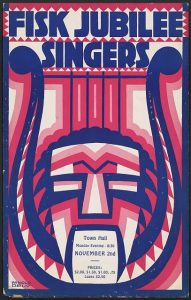Musicians’ public reception begins before they play a single note. The advertisements for their performances preview who they are and what kind of music they make. I was captivated by a poster for a Fisk Jubilee Singers concert between 1910 and 1950, designed by Winold Reiss. The artwork offers insight into who they were performing for and what themes the performance might have had.

Winold Reiss, “[Graphic Design for Fisk Jubilee Singers.] [Concert Poster with Harp and Mask Motif],” still image, last modified 1910, accessed October 4, 2021, https://www.loc.gov/pictures/ resource/ppmsca.64409.
While the Library of Congress lists 1910 as the earliest potential date of publication, the fact that Reiss had not yet moved to America makes this improbable. Still, he was devoted to non-white subjects, known for his portraits of the Blackfoot and Blood Indians of Canada and the northwestern United States. The Reiss Partnership summarizes the perspective he brought to his art, stating that,
“His idealism challenges the notion that as Americans we are anything less than “us,” a totality that includes rather than excludes.”2
To be clear, Reiss should not be seen as a sort of white savior just for making art that centers Black and Indigenous folks. However, his idea of creating an inclusive American identity mirrors the Fisk Jubilee Singers’ history, and later, this poster.
